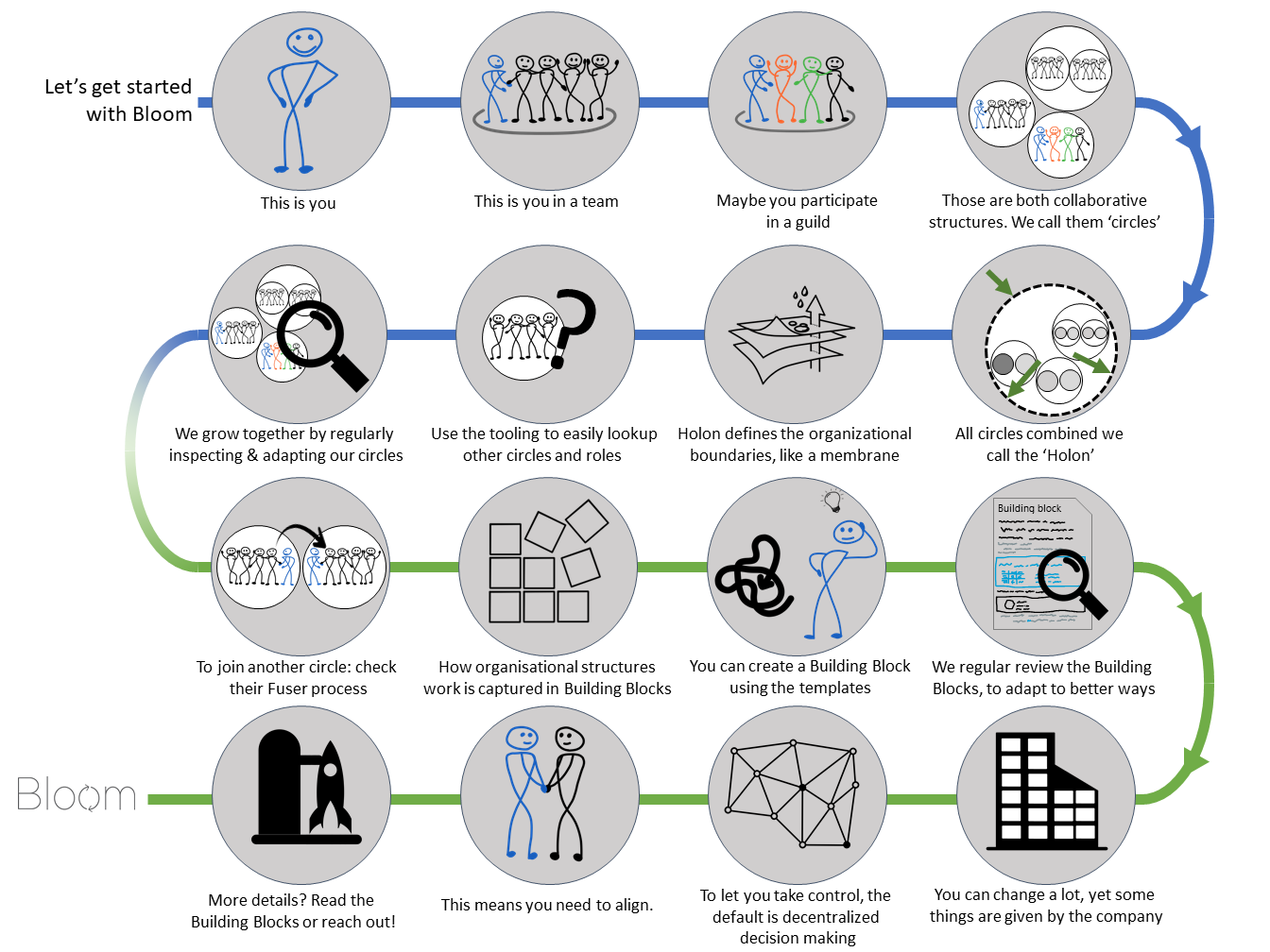What is Bloom
Bloom is an organizational model and a framework to self-organize.
In Bloom all employees can safely evolve their organization without the need for centralized management
When change is the only constant, master changing
Mastering organizational change
Learn by doing, reflect, move forward and repeat. Bloom is an organizational model that sparks organizational evolutions. While many organizations know how to be agile on team level and some can even scale agile product delivery, few can say they are agile on how they are organized.
Bloom masters organizational change through making changes smaller and easier. With practice comes mastery.
Bloom allows to have many small iterative organizational changes. Change not created by management, but by those who are impacted by it. Mastering organizational change means you can change often and safely. Moving your organization forward by shaping the organization and reshaping it according to the needs that are present now and in the foreseeable future.
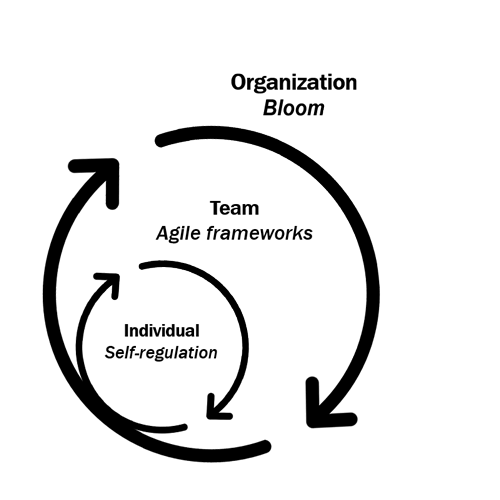
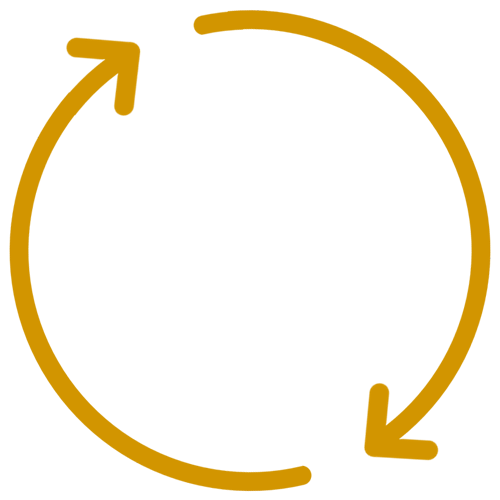


Learn by doing, reflect, move forward and repeat. Bloom is an organizational model that sparks organizational evolutions. While many organizations know how to be agile on team level and some can even scale agile product delivery, few can say they are agile on how they are organized.
Bloom masters organizational change through making changes smaller and easier. With practice comes mastery.
Bloom allows to have many small iterative organizational changes. Change not created by management, but by those who are impacted by it. Mastering organizational change means you can change often and safely. Moving your organization forward by shaping the organization and reshaping it according to the needs that are present now and in the foreseeable future.
Collective improvements
Changing the organization is often about how we work together (teams, people, roles/functions, hierachy) and how we do things (the formal and informal agreements).
Bloom addresses both.

How we work together
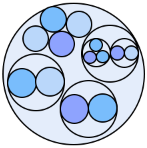
In Bloom the people and groups are visualized through circles and the roles that people fulfill. Everybody can capture this and when something changes, everybody can easily make that transparent. It favours the intelligence of the many over the few. Bloom does this by distributing authority instead of centralizing it.
It’s built to be able to do a thousand small changes throughout a year instead of a big reorganization once a year.
How we do things

The ‘how we do things’ of an organization are captured in Building Blocks. Every block describes how something works. There are two types: Core and Practice Building Blocks.
Core Building Blocks make self-organization possible. Practice Building Blocks make explicit how we do things in the context of self-organization.
For example how (agile) budgeting is done, how vacancies are filled or the agreements about recruitment in your self-organization context.
Everyone is able to review and adjust existing building blocks or creating new ones. Building the organization block by block.
Doing the change
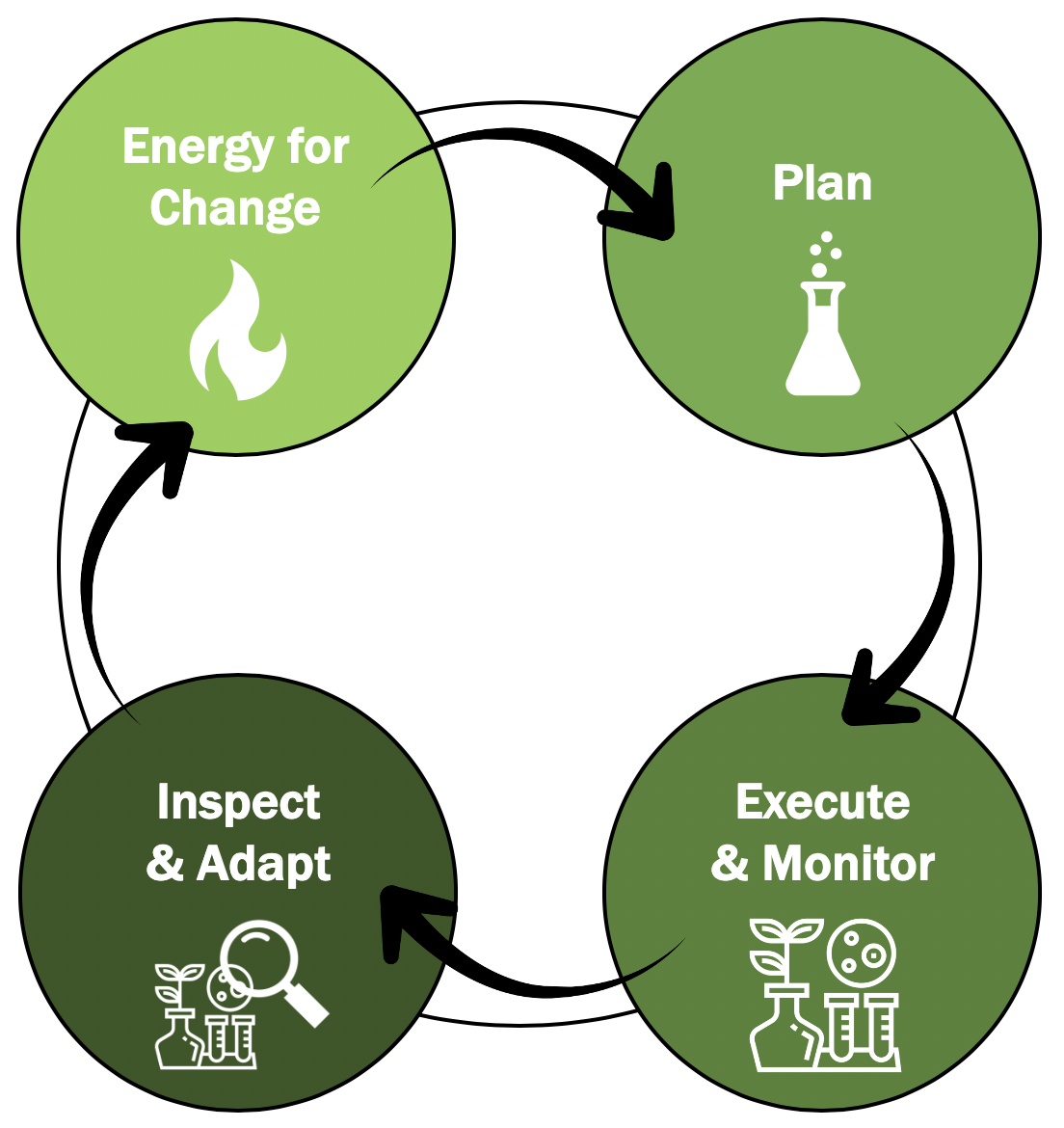
Change is not new. What’s new in Bloom is that barriers to organizational change are drastically lowered. Making it easier, smaller and less risky. Those who have the energy to change the organization can do so. Not through chaos, but through careful consideration what’s best for the organization.
It works through the Building Blocks. They capture the agreements and can be changed when someone sets out to improve the organization. It’s Plan → Execute & Monitor → Inspect & Adapt. This last part is key.
Embracing Inspect & Adapt for organizational changes is the main ingredient to have continuous feedback loops. It sparks new ideas and is fuel to be able to continuously improve the organization. Embedding this enable you to go from big, scary overhauls of your organization into many smaller, less risky changes.
How to embed this? That’s why Bloom has a Core. In Bloom it’s the place where you formalize how self-organization is done at your organization.

If you don’t do it by the book, change the book.
The Bloom Core
The Bloom Core is how collective change is made possible. It’s at the centre of it all and defines how self-organization works in the organization.
The Core is different per organization. No organization is the same and no organization does self-organization the same way. Consider the Core to be the operating system of your self-organization. Not a rigid operating system, but a flexible and adjustable one. It adjusts based on what makes sense in your context.
The Core consists of Building Blocks. Each Core Building Block is a distinct part of how the organization agrees to do self-organization. This connected set of Building Blocks together form the Core and it formalizes how collective change is done.
Every organization is different and there is no one-size-fits-all on how you should be organized. Bloom is open source so you can freely alter it and you’re encouraged to do so. Start with the current Bloom Core and shape it in a way that fits your organization.
How Bloom relates to what you already know
To understand what Bloom is, it’s helpful to know how it’s different. This is a limited list of how Bloom relates to what you might already know. Click on a topic for a short explainer.
Organizational models
Organizational models are the formal format in which an organization is organized. It defines how power, authority and responsibilities are divided. Some models centralize power, Bloom distributes it. Some models are rigid, Bloom is flexible.
Processing work
Processing work is about going from A to B, getting things done & achieving results. It’s where organizations create value through their efforts. Bloom focus is one level deeper: the organizational model. Bloom focuses on the underlying infrastructure and Bloom can easily integrate a diverse set of (Agile) frameworks into an organization.
Scaling Agile frameworks
Scaling Agile frameworks focus on efficient product delivery on a larger scale: more than one team. To do this they give guidance on how to be organized. While Scaled Agile Frameworks are partially about the organization, Bloom is solely about the organization.
blank
Organizational chart
Bloom is in many ways different from an organizational chart. These are the main three differences:
- Where in an org-chart the power goes up, in Bloom power and authority are decentralized.
- Where the org-chart draws people and departments in a line organization, in Bloom people have roles and roles are part of circles.
- The org-chart focuses on which authority is allocated to whom. Bloom is broader and takes in more aspects of what it means to be an organization.
Holacracy
Holacracy and Bloom both decentralize authority, promote self-organization and visualize the organization through circles and roles. The differences between Holacracy and Bloom is how that is achieved.
Where Holacracy has the Constitution as a procedural lawbook to do self-organization, Bloom has a flexible Core to make collective change possible. The Constitution centralizes the power to change the Constitution, Bloom decentralizes changing Bloom’s Core. Where the Constitution leans on procedural mechanics to move the organization forward, Bloom’s holds an open source attitude towards change: let those who are able, change the organization for the better.
Sociocracy 3.0
Sociocracy 3.0 (S3) and Bloom both strive for more people-oriented and better collaborative organizations. There is a main difference in the approach: S3’s starting point are Drivers and using Patterns as an a-la-carte menu. Bloom has Bloom’s Core which is one package, whereby you’ve tweaked it to fit your organization.
Bloom starts as a formalization of how your organization sees self-organization working. It embeds the principles of decentralized authority in one package: Bloom’s Core. That’s different from S3, where it is pick and choose.
There are similarities as well. Where S3 has Patterns to distinguish elements of an organization, Bloom uses Building Blocks. Where S3 is built on seven principles, Bloom has ‘Core Elements’ which capture the organizational principles.
Matrix
Where in a Matrix organization authority and power is centralized among two axes, in Bloom authority is distributed to support self-organization. Bloom is not restricted by only defining how authority is distributed, but is a framework that involves other aspects of an organization as well.
blank
Your content goes here. Edit or remove this text inline or in the module Content settings. You can also style every aspect of this content in the module Design settings and even apply custom CSS to this text in the module Advanced settings.
Scrum
Scrum is a framework for developing and sustaining complex products. Bloom does not describe nor change this. Scrum operates at a team level, where Bloom operates on an organizational level. Scrum and Bloom can easily co-exist. Bloom can enhance Scrum’s potential by making transparent how Scrum integrates into the organization.
Design Thinking
Design Thinking is a people oriented approach of innovation. Design Thinking operates as a process as well as a mindset. Where Design Thinking is there to grow product innovation, Bloom grows the organization. Both Bloom and Design Thinking utilize feedback loops for growing ideas. Design Thinking can be part of the way of working within Bloom. The two can easily co-exist.
Getting Things Done
Getting Things Done (GTD) is a time management method. GTD operates at the personal level, where Bloom operates on an organizational level. Bloom does not prescribe how to be personally efficient. GTD and Bloom can co-exist without friction.
Project management
Project management is a tool to achieve specific work goals and meet criteria. Where project management is about getting projects done, Bloom is about improving the organization.
Blank
Your content goes here. Edit or remove this text inline or in the module Content settings. You can also style every aspect of this content in the module Design settings and even apply custom CSS to this text in the module Advanced settings.
LeSS
LeSS is a scaled up version of one-team Scrum, and it maintains many of the practices and ideas of one-team Scrum. It’s mainly about processing work, less so on organizational change. LeSS and Bloom can co-exist safely. Bloom can enhance LeSS’ potential by making transparent how it integrates into the organization.
SAFe
The Scaled Agile Framework (SAFe) is a set of organization and workflow patterns to guide enterprises in scaling lean and agile practices. The SAFe framework is a complete and strict framework. Where Bloom’s focus is entirely on the organization, SAFe is partly organization and partly processing work.
Integrating Bloom and SAFe is not possible without harming principles in either one. SAFe does not allow itself to be modified, while Bloom will allow for it.
Nexus
Nexus is a framework for developing and sustaining scaled product and software delivery initiatives. It uses Scrum as its building block. It’s mainly about processing work, less so on organizational change. Bloom and Nexus can safely co-exist and Bloom can enhance Nexus’ potential by making transparent how it integrates into the organization.
Spotify Model
The Spotify Model is an inspirational work from Spotify. It’s about their engineering culture and what they at the time of publishing did and aimed for.
How Bloom relates is that both use Agile principles and both value to continuously do inspect & adapt. They are different as Bloom is an organizational model, focusing on the organizational infrastructure for self-organization, whereby the Spotify Model combines a set of practices and guidelines to be used as inspiration by others.
Bloom framework: the Start Guide
This Start Guide is a short intro in how Bloom is from an individual perspective.
